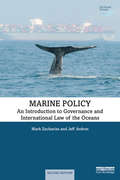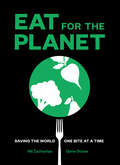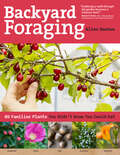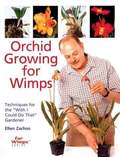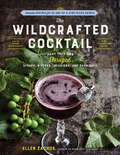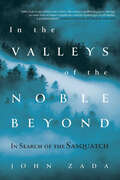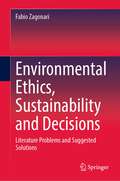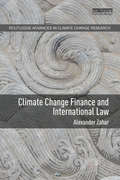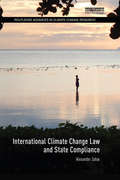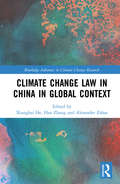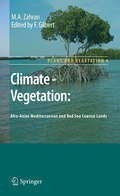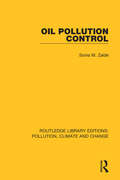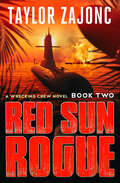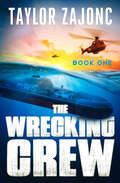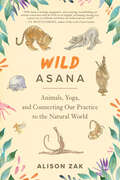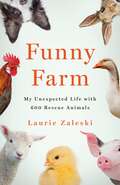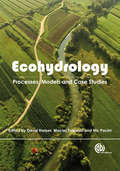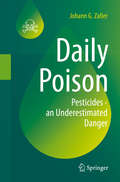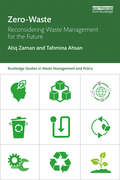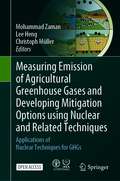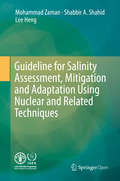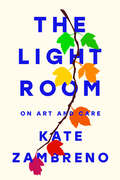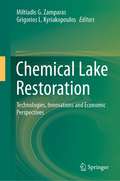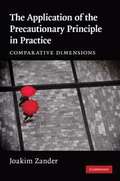- Table View
- List View
Marine Policy: An Introduction to Governance and International Law of the Oceans (Earthscan Oceans)
by Mark Zacharias Jeff ArdronThis book provides readers with a foundation in policy development and analysis, describing how policy, including legal mechanisms, are applied to the marine environment. It presents a systematic treatment of all aspects of marine policy, including climate change, energy, environmental protection, fisheries, mining and transportation. The health of marine environments worldwide is steadily declining, and these trends have been widely reported. Marine Policy summarizes the importance of the ocean governance nexus, discussing current and anticipated challenges facing marine ecosystems, human activities, and efforts to address these threats. This new, fully revised edition has been updated throughout, including content to reflect the recent advances in ocean management and international law. Chapters on shipping, energy/mining and integrated approaches to ocean management have been significantly reworked, plus completely new chapters on the United Nations Convention on the Law of the Sea, and the impacts of climate change have been added. Pedagogical features for students are included throughout. Aligned with current course offerings, this book is an ideal introduction for undergraduates and graduate students taking marine affairs, science and policy courses.
Eat for the Planet: Saving the World One Bite at a Time
by Nil Zacharias Gene Stone“An indispensable guide for anyone who wants to live to age 100—by making sure there’s a livable world when you get there.” —Dan Buettner, New York Times–bestselling author of The Blue ZonesDo you consider yourself an environmental ally? Maybe you recycle your household goods, ride a bike, and avoid too much air travel. But did you know that the primary driver of climate change isn’t plastics, or cars, or airplanes? Did you know that it’s actually our industrialized food system? In this fascinating new book, authors Nil Zacharias and Gene Stone share new research, intriguing infographics, and compelling arguments that support what scientists across the world are beginning to affirm and uphold: By making even minimal dietary changes, anyone can have a positive, lasting impact on our planet. If you love the planet, the only way to save it is by switching out meat for plant-based meals, one bite at a time.“This fascinating, easy-to-read book will give you still another reason to eat plants and not animals: you will be doing a world of good—literally!” —Rip Esselstyn, #1 New York Times–bestselling author of Plant-Strong“Eating plants is not just good for your own health, it’s imperative for the health of the planet. This well-argued, well-written book makes it clear why everyone should consider a plant-based diet today.” —Michael Greger, MD, New York Times–bestselling author of How Not to Die“Possibly the single most important environmental book I’ve read in years. A must for everyone.” —Kathy Freston, New York Times–bestselling author of The Lean
Backyard Foraging: 65 Familiar Plants You Didn't Know You Could Eat
by Ellen ZachosThere’s food growing everywhere! You’ll be amazed by how many of the plants you see each day are actually nutritious edibles. Ideal for first-time foragers, this book features 70 edible weeds, flowers, mushrooms, and ornamental plants typically found in urban and suburban neighborhoods. Full-color photographs make identification easy, while tips on common plant locations, pesticides, pollution, and dangerous flora make foraging as safe and simple as stepping into your own backyard.
How to Forage for Wild Foods without Dying: An Absolute Beginner's Guide to Identifying 40 Edible Wild Plants
by Ellen ZachosThis on-the-go guide is perfect for new foragers eager to learn about the edible plants they're most likely to find, no matter what region they're in, and provides photos and easy-to-follow identification and use guidelines for the 40 most common—and most delicious—wild plants.How to Forage for Wild Foods without Dying is a book for anyone who likes to go on nature walks and would like to learn about the edible plants they&’re most likely to come across—no matter what region they&’re in. Author Ellen Zachos shares her considerable expertise, acquired over decades of foraging in every part of North America. She offers clear, concise descriptions of edible wild plants, in addition to any potential lookalikes, as well as critical information about proper harvesting, processing, and cooking. Zachos has curated the plant selection to include only the 40 most common, most delicious edible plants, ranging from black walnuts and juniper berries to elderflowers, burdock, fiddlehead ferns, lambsquarter, wild garlic, sunchokes, and many more. With Zachos&’s expert advice and easy-to-follow guidelines, readers will be confident in identifying which plants they can safely eat and which ones they should definitely avoid. Easy instructions for preparation and eating for maximum enjoyment are included.
Orchid Growing for Wimps
by Ellen ZachosA superb primer on orchid culture. It uses a step-by-step approach and doesn't skimp on relating complete details. There's a chapter showing easy-to-grow orchids in all their glory, and there's also a chapter warning about 'difficult' orchids to avoid. This book takes you on a visit to 16 terrific varieties you can easily handle.
The Wildcrafted Cocktail: Make Your Own Foraged Syrups, Bitters, Infusions, and Garnishes; Includes Recipes for 45 One-of-a-Kind Mixed Drinks
by Ellen ZachosMeet the natural lovechild of the popular local-foods movement and craft cocktail scene. It’s here to show you just how easy it is to make delicious, one-of-a-kind mixed drinks with common flowers, berries, roots, and leaves that you can find along roadsides or in your backyard. Foraging expert Ellen Zachos gets the party started with recipes for more than 50 garnishes, syrups, infusions, juices, and bitters, including Quick Pickled Daylily Buds, Rose Hip Syrup, and Chanterelle-infused Rum. You’ll then incorporate your handcrafted components into 45 surprising and delightful cocktails, such as Stinger in the Rye, Don’t Sass Me, and Tree-tini.
In the Valleys of the Noble Beyond: In Search of the Sasquatch
by John ZadaA journalist travels through British Columbia exploring of one of the world’s most baffling mysteries?the existence of the Sasquatch.On the central and north coast of British Columbia, the Great Bear Rainforest is the largest intact temperate rainforest in the world, containing more organic matter than any other terrestrial ecosystem on the planet. The area plays host to a wide range of species, from thousand-year-old western cedars to humpback whales to iconic white Spirit bears.According to local residents, another giant is said to live in these woods. For centuries people have reported encounters with the Sasquatch—a species of hairy bipedal man-apes said to inhabit the deepest recesses of this pristine wilderness. Driven by his own childhood obsession with the creatures, John Zada decides to seek out the diverse inhabitants of this rugged and far-flung coast, where nearly everyone has a story to tell, from a scientist who dedicated his life to researching the Sasquatch, to members of the area’s First Nations, to a former grizzly bear hunter-turned-nature tour guide. With each tale, Zada discovers that his search for the Sasquatch is a quest for something infinitely more complex, cutting across questions of human perception, scientific inquiry, indigenous traditions, the environment, and the power and desire of the human imagination to believe in—or reject—something largely unseen.Teeming with gorgeous nature writing and a driving narrative that takes us through the forests and into the valleys of a remote and seldom visited region, In the Valleys of the Noble Beyond sheds light on what our decades-long pursuit of the Sasquatch can tell us about ourselves and invites us to welcome wonder for the unknown back into our lives.Praise for In the Valleys of the Noble Beyond“Books on supernatural phenomena typically steer one of two courses: tabloid gullibility or mean-spirited debunkery. Zada deftly tightropes between the two. . . . In the Valleys of the Noble Beyond is not really about sasquatch. It is about how we see what we want to see and don’t see what we’re not prepared to see. . . . A quirky and oddly captivating tale.” —Eric Weiner, Washington Post“An adventure story in the tradition of Paul Theroux and, in parts, Jon Krakauer. . . . Zada is a latter-day Henry David Thoreau or John Muir. . . . Searching for an elusive ape, Zada has a knack for meeting unforgettable humans.” —Peter Kuitenbrouwer, Globe and Mail“If people can believe in God, why not Sasquatch? Zada takes us through the temperate rainforest of British Columbia looking for both the hairy bipedal and the mythology and landscape surrounding it. Terrific nature writing with a furry twist.” —Kerri Arsenault, Orion
Environmental Ethics, Sustainability and Decisions: Literature Problems and Suggested Solutions
by Fabio ZagonariThis book provides a summary of the main concepts involved in environmental ethics, sustainability and decisions and a consistent sequence of environmental ethics, sustainability and decisions. It presents many environmental ethics, by focusing on maximising welfare within teleological approaches and minimising inequalities within deontological approaches. It presents many sustainability paradigms, by focusing on weak sustainability to maximise welfare and strong sustainability to minimise inequalities. Two main decisions are presented by focusing on policies (taxes, standards, subsidies, permits, protected areas, exploitation rights) and projects (CBA) towards efficiency to maximise welfare and policies (national laws/regulations, bilateral/multilateral agreements) and projects (MCA) towards equity to minimise inequalities.
Climate Change Finance and International Law (Routledge Advances in Climate Change Research)
by Alexander ZaharSince 2010, a significant quantity of international climate change finance has begun to reach developing countries. However, the transfer of finance under the international climate change regime – the legal and ethical obligations that underpin it, the constraints on its use, its intended outcomes, and its successes, failures, and future potential – constitutes a poorly understood topic. Climate Change Finance and International Law fills this gap in the legal scholarship. The book analyses the legal obligations of developed countries to financially support qualifying developing countries to pursue globally significant mitigation and adaptation outcomes, as well as the obligations of the latter under the international regime of financial support. Through case studies of climate finance mechanisms and a multitude of other sources, this book delivers a rich legal and empirical understanding of the implementation of states’ climate finance obligations to date. The book will be of interest to scholars and students of international law and policy, international relations, and the maturing field of climate change law.
International Climate Change Law and State Compliance (Routledge Advances in Climate Change Research)
by Alexander ZaharA solution to the problem of climate change requires close international cooperation and difficult reforms involving all states. Law has a clear role to play in that solution. What is not so clear is the role that law has played to date as a constraining factor on state conduct. International Climate Change Law and State Compliance is an unprecedented treatment of the nature of climate change law and the compliance of states with that law. The book argues that the international climate change regime, in the twenty or so years it has been in existence, has developed certain normative rules of law, binding on states. State conduct under these rules is characterized by generally high compliance in areas where equity is not a major concern. There is, by contrast, low compliance in matters requiring a burden-sharing agreement among states to reduce global greenhouse gas emissions to a ‘safe’ level. The book argues that the substantive climate law presently in place must be further developed, through normative rules that bind states individually to top-down mitigation commitments. While a solution to the problem of climate change must take this form, the law’s development in this direction is likely to be hesitant and slow.The book is aimed at scholars and graduate students in environmental law, international law, and international relations.
Climate Change Law in China in Global Context (Routledge Advances in Climate Change Research)
by Alexander Zahar Hao Zhang Xiangbai HeIn Climate Change Law in China in Global Context, seven climate change law scholars explain how the country’s legal system is gradually being mobilized to support the reduction of greenhouse gas emissions in China and achieve adaptation to climate change. There has been little English scholarship on the legal regime for climate change in China. This volume addresses this gap in the literature and focuses on recent attempts by the country to build defences against the impacts of climate change and to meet the country’s international obligations on mitigation. The authors are not only interested in China’s laws on paper; rather, the book explains how these laws are implemented and integrated in practice and sheds light on China’s current laws, laws in preparation, the changing standing of law relative to policy, and the further reforms that will be necessary in response to the 2015 Paris Agreement on Climate Change. This comprehensive and critical account of the Chinese legal system’s response to the pressures of climate change will be an important resource for scholars of international law, environmental law, and Chinese law.
Climate - Vegetation: Afro-Asian Mediterranean and Red Sea Coastal Lands (Plant and Vegetation #4)
by M. A. Zahran Francis GilbertDeserts are unique ecosystems with their own biotic and abiotic components, and are often rich in renewable natural resources, the appropriate management of which can contribute significantly to the sustainable management of desert regions for the welfare of the people. Yet while there are many books on the flora of the countries fringing the important desert countries of the Mediterranean and Red Seas, there or few books reporting on their ecophysiology and vegetation ecology. This book presents the vegetation types of the African and Asian countries of the Mediterranean and Red Sea coastal regions, and discusses the ecological threats and economic applications of these critical resources. In particular, it examines the relationships between climate and vegetation, and discusses these within the context of desertification, agro-industrial applications, ecotourism and sustainable development. The book will provide a valuable reference for researchers and graduate students involved in plant ecology, biogeography, economic botany and environmental management in the Afro-Asian Mediterranean and Red Sea coastal regions, as well as other desert regions around the world.
Oil Pollution Control
by Sonia M. ZaideOil pollution has been a major environmental concern since the 1920s. The search for a solution has ranged from prevention to partial measures coupled with compensation and remedial action. This book, originally published in 1987, offers a different assessment of the efforts of governments and the oil and maritime industries. It was also the first book to provide a comprehensive story of control policies and practices, using primary and secondary sources. The book identified numerous factor – personalities, state policies, developments in the oil and shipping industries, public agitation and scientific studies in a framework useful for analysing any environmental problem.
Red Sun Rogue (The Wrecking Crew Novels)
by Taylor ZajoncAs an unknown enemy wreaks havoc in the South China Sea, a renegade submarine captain untangles a deadly conspiracy rooted in lost WWII technology. Salvage diver–turned–submarine captain Jonah Blackwell and his crew are on a covert mission of mercy, spiriting refugees out of North Korea as a hundred-year winter ravages the Pacific. Hunted by the Japanese fleet and forced to surrender, Jonah and his crew must race against time in an adventure spanning the irradiated waters of Fukushima, flood-beset Tokyo, and the crumbling tropical remains of a secret research facility. At the center of it all is an enigmatic Japanese technology cult with roots in the clandestine weapons program of the Second World War—a cult that has waited seventy years to strike its final blow.
The Wrecking Crew (The Wrecking Crew Novels)
by Taylor Zajonc&“Fans of action-packed thrillers with nautical settings will be more than satisfied with Zajonc&’s accomplished debut, which kicks off a promising series&” —Publishers Weekly, starred review). The pirate-plagued waters of Somalia have gotten even more deadly since a mysterious red tide began killing all marine life within its reach. When a research team attempting to study the phenomenon is shot out of the sky, extraordinary measures are required to investigate. In exchange for his freedom from a secret Moroccan prison, salvage diver Jonah Blackwell agrees to lead a covert search for the missing scientists. But when his expedition threatens the ambitions of billionaire industrialist Charles Bettencourt, Jonah must assemble an untested crew to discover the source of a terrifying plague while facing down Bettencourt&’s private army.
Wild Asana: Animals, Yoga, and Connecting Our Practice to the Natural World
by Alison ZakEver wonder about the dog in Downward Dog or the pigeon in Kapota? Rewild your yoga practice by connecting to the animals behind the asanas.For nature-loving yogis and readers of World of Wonders and Yoga MythologyFrom Downward Dog to Cobra, Wild Asana invites you into an embodied exploration of the animals that inspire familiar yoga poses. Drawing on wildlife science, anthropology, Hindu mythology, Eastern philosophy, and personal stories, this insightful guide by environmental educator and yoga instructor Alison Zak explores the connections among our bodies, our minds, and the animals that inspire our practice.In illustrated chapters on asanas like Tittibhasana (Firefly), Garudasana (Eagle), Bidalasana (Cat), and Ustrasana (Camel), Zak invites you to bring the deep nature of animals into breath and movement.You&’ll learn to: Respect the monkey in &“monkey mind&” to honor—not tame—your own wildnessFly like an eagle to move from imprisonment to liberation Embody a pigeon&’s stillness and nonattachmentImbue your practice with the agility, flexibility, and fierce commitment of a cat Incorporate asana variations, mudras, and meditations inspired by animal naturePractice lovingkindness meditations that include the more-than-human world With an encompassing ecological compassion, gorgeous original illustrations, profound insight into animal wisdom, and the humor and perspective of lived experience, Zak offers a path to deepen and enliven your practice. Whether you&’re an animal lover, a first-time yoga student, or an experienced practitioner, Wild Asana is a practical and accessible guide to becoming animal on your yoga mat.
Funny Farm: My Unexpected Life with 600 Rescue Animals
by Laurie ZaleskiAn inspiring and moving memoir of the author's turbulent life with 600 rescue animals.Laurie Zaleski never aspired to run an animal rescue; that was her mother Annie’s dream. But from girlhood, Laurie was determined to make the dream come true. Thirty years later as a successful businesswoman, she did it, buying a 15-acre farm deep in the Pinelands of South Jersey. She was planning to relocate Annie and her caravan of ragtag rescues—horses and goats, dogs and cats, chickens and pigs—when Annie died, just two weeks before moving day. In her heartbreak, Laurie resolved to make her mother's dream her own. In 2001, she established the Funny Farm Animal Rescue outside Mays Landing, New Jersey. Today, she carries on Annie’s mission to save abused and neglected animals.Funny Farm is Laurie’s story: of promises kept, dreams fulfilled, and animals lost and found. It’s the story of Annie McNulty, who fled a nightmarish marriage with few skills, no money and no resources, dragging three kids behind her, and accumulating hundreds of cast-off animals on the way. And lastly, it's the story of the brave, incredible, and adorable animals that were rescued. Although there are some sad parts (as life always is), there are lots of laughs.
Ecohydrology: An Approach to the Sustainable Management of Water Resources
by Maciej Zalewski Nic Pacini David HarperEcohydrology is an emerging new sub-discipline which links elements of ecology with hydrology at all points in the water cycle, ranging in scale from water-plant physiological relationships to whole catchment water-ecosystem processes. This book pays most attention to the larger scales of ecohydrology, emphasizing the use of this tool in striving towards the goal of sustainable water management. Authors from Eastern and Western Europe, America, Australia and South Africa give a broad global context.
Daily Poison: Pesticides - an Underestimated Danger
by Johann G. ZallerThis book is a sound science report about the consequences of pesticides to nature, health and environment.The book shares essential insights into the use of pesticides in agriculture, discusses the politics, rhetoric and profits involved, addresses the potential health and ecological risks of pesticides in our daily lives, and debates possible solutions. Does sustainable agriculture exist, and is agriculture without pesticides possible at all?Moreover, the author gives insight into his scientific work, the set-up of the experiments, and also writes about his very own experiences with the media and press after publication of his studies.For many years, Johann G. Zaller, an ecologist at the University of Natural Resources and Life Sciences in Vienna, and his team, have been researching applied chemicals and their effects on the environment. Their findings, together with relevant literature and media reports, are presented in this book, which offers a unique resource for anyone who wants to know the nature and background of pesticides and how we come into contact with them in our daily lives. Ever ate an apple? Read this book!
Zero-Waste: Reconsidering Waste Management for the Future (Routledge Studies in Waste Management and Policy)
by Atiq Zaman Tahmina AhsanThis book analyses ‘zero-waste’ (ZW) as an emerging waste management strategy for the future, which considers waste prevention through innovative design and sustainable consumption practices. Drawing on a diverse range of case studies from Australia, Bangladesh, Japan, New Zealand, Sweden, and the USA, this book explores why urban waste management systems still remain a major challenge for almost all cities around the world. Rejecting waste as an ‘end-of-life’ problem, Atiq Zaman and Tahmina Ahsan instead consider waste prevention through the ZW model, in which resources are utilized and consumed with minimum environmental degradation. In addition, the authors give extended discussion on why embracing the ZW concept will be beneficial for the circular economy (CE). Providing a strategic zero-waste framework and an evaluation tool to measure waste management performance aimed towards ZW goals, this book will be of great relevance to students, scholars, and policymakers with an interest in waste management, sustainable consumption, urban planning, and sustainable development.
Measuring Emission of Agricultural Greenhouse Gases and Developing Mitigation Options using Nuclear and Related Techniques: Applications of Nuclear Techniques for GHGs
by Mohammad Zaman Lee Heng Christoph MüllerThis open access book is an outcome of the collaboration between the Soil and Water Management & Crop Nutrition Section, Joint FAO/IAEA Division of Nuclear Techniques in Food and Agriculture, Department of Nuclear Sciences and Applications, International Atomic Energy Agency (IAEA), Vienna, Austria, and the German Science Foundation research unit DASIM (Denitrification in Agricultural Soils: Integrated control and Modelling at various scales) and other institutes. It presents protocols, methodologies and standard operating procedures (SOPs) for measuring GHGs from different agroecosystems and animals using isotopic and related techniques that can also be used to validate climate-smart agricultural practices to mitigate GHGs. The material featured is useful for beginners in the field wanting an overview of the current methodologies, but also for experts who need hands-on descriptions of said methodologies. The book is written in form of a monograph and consists of eight chapters.
Guideline for Salinity Assessment, Mitigation and Adaptation Using Nuclear and Related Techniques
by Mohammad Zaman Shabbir A. Shahid Lee HengThis open access book is an outcome of the collaboration between the Soil and Water Management & Crop Nutrition Section, Joint FAO/IAEA Division of Nuclear Techniques in Food and Agriculture, Department of Nuclear Sciences and Applications, International Atomic Energy Agency (IAEA), Vienna, Austria, and Dr. Shabbir A Shahid, Senior Salinity Management Expert, Freelancer based in United Arab Emirates.The objective of this book is to develop protocols for salinity and sodicity assessment and develop mitigation and adaptation measures to use saline and sodic soils sustainably. The focus is on important issues related to salinity and sodicity and to describe these in an easy and user friendly way. The information has been compiled from the latest published literature and from the authors’ publications specific to the subject matter. The book consists of six chapters. Chapter 1 introduces the terms salinity and sodicity and describes various salinity classification systems commonly used around the world. Chapter 2 reviews global distribution of salinization and socioeconomic aspects related to salinity and crop production. Chapters 3 covers comprehensively salinity and sodicity adaptation and mitigation options including physical, chemical, hydrological and biological methods. Chapter 4 discusses the efforts that have been made to demonstrate the development of soil salinity zones under different irrigation systems. Chapter 5 discusses the quality of irrigation water, boron toxicity and relative tolerance to boron, the effects of chlorides on crops. Chapter 6 introduces the role of nuclear techniques in saline agriculture.
The Light Room
by Kate Zambreno&“Kate Zambreno has invented a new form. It is a kind of absolute present, real life captured in closeup.&“ —Annie Ernaux, winner of the Nobel Prize in Literature From &“one of our most formally ambitious writers&” (Esquire), a moving account of caretaking in a time of uncertainty and lossIn The Light Room, Zambreno offers her most profound and affecting work yet: a candid chronicle of life as a mother of two young daughters in a moment of profound uncertainty about public health, climate change, and the future we can expect for our children. Moving through the seasons, returning often to parks and green spaces, Zambreno captures the isolation and exhaustion of being home with a baby and a small child, but also small and transcendent moments of beauty and joy. Inspired by writers and artists ranging from Natalia Ginzburg to Joseph Cornell, Yūko Tsushima to Bernadette Mayer, Etel Adnan to David Wojnarowicz, The Light Room represents an impassioned appreciation of community and the commons, and an ecstatic engagement with the living world.How will our memories, and our children&’s, be affected by this time of profound disconnection? What does it mean to bring new life, and new work, into this moment of precarity and crisis? In The Light Room, Kate Zambreno offers a vision of how to live in ways that move away from disenchantment, and toward light and possibility.
Chemical Lake Restoration: Technologies, Innovations and Economic Perspectives
by Miltiadis G. Zamparas Grigorios L. KyriakopoulosThis book aims to structure, in a complete and sequential way, the mainstream technical knowledge which is related to eutrophication control. The book considers the development of innovative technologies for phosphate removal, while supporting the restoration of currently degraded lakes and reservoir systems. In addition, this book contains key-aspects of future benchmark interests being specially framed under the ongoing development of a circular economy. In particular, the book will contribute to a better understanding of the problem of internal P-loads and P-sources disposition towards a more effective control of nutrients’ enrichment in lakes. The chemical routes and environmental fate of such lake nutrients will be viewed in the light of innovative technologies (engineering dimensions) and circular economy perspectives (economics dimensions). The main theme extends to an economic appreciation of environmental polluted aquifers. The book will appeal to an interdisciplinary audience, covering a wide spectrum of scientific fields, such as environment, physical chemistry, surface chemistry, interfacial phenomena, coastal engineering, bio-engineering, environmental policy makers, and economists.
The Application of the Precautionary Principle in Practice
by Joakim ZanderThis overview of the role played by the precautionary principle in international trade law, European law and national law compares how precautionary considerations have been applied in the fields of pesticide regulation and the regulation of base stations for mobile telephones in Sweden, the UK and the US. A number of problems in the current application of the precautionary principle are identified and discussed. For example, it is shown that a firm reliance on a wide and open-ended precautionary principle may lead to problems with the consistency, foreseeability, effectiveness and efficiency of measures intended to reduce environmental or health risks. It is suggested that the precautionary principle indeed may be an important tool, but that in order to be acceptable it must be coupled with strong requirements on the performance of risk assessments, cost/benefit analyses and risk trade-off analyses.
